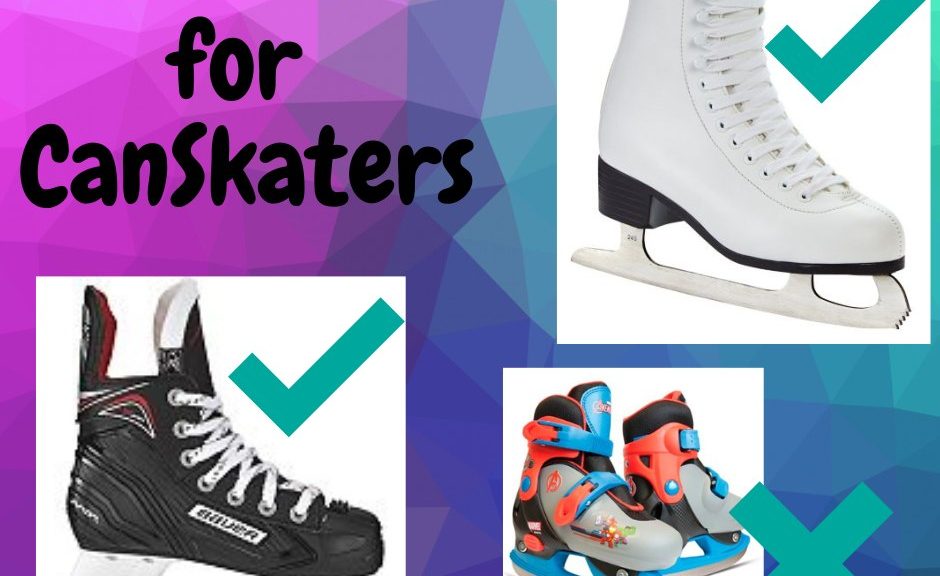Information on Choosing Skates/Care of Skates & What to Wear Skating
Buying Skates – Starting Out
There are 2 common misconceptions with figure skates. The first is that it’s better for a beginner to skate on dull blades. This is not only false, but dangerous. No one should ever skate on dull or unsharpened blades. Your skating edge will help you turn and maneuver, as well as keep your balance.
The second is that people with weak ankles cannot skate. This actually has more to do with the skate, than the skater. When you go skate shopping, ensure that you choose a skate that is stiff enough to support the skaters ankles for their weight, and for what level they are in. If the skates bend at the ankle, causing the skater to skate “on the ankle” they are not strong enough. Using skates like this can cause serious damage to ankles, as well as not allowing the skater to do their best or learn properly.
Fit – you should be able to fit a finger down the back of the skate if the foot is all the way forward. When you are trying on skates, make sure you are wearing (on your feet) what you will be wearing in your skates, to ensure a proper fit.
Keep them sharp — but not too sharp: A sharp blade grabs the ice better than a dull one. Sharpen your blades when they start to slide uncomfortably when you land. Keep a log of the number of hours you skate between sharpening. After a while you’ll figure out how many hours you can average between sharpening, and this will help you to avoid surprises at inconvenient times. If your child competes, it is best not to sharpen their skates right before a competition, try to give them a couple of weeks to skate on freshly sharpened blades before they need to compete on them.
You want a balance here — if you wait too long, the change when you get them sharpened is pretty dramatic and your performance suffers. If you do it too often, you’ll wear out the blade too soon (yes, there is a finite number of times a blade can be sharpened). On average, you should have your skates sharpened every 20 – 30 hours of skating.
Sharpen responsibly too — be careful of who you trust with your blades. If the place you go doesn’t have a specialist in figure skates, be careful. Figure skates are sharpened with very different goals than hockey skates. Never have them done by one of those automatic machines you find in some rins. Figure skates are ground with a “hollow” in the bottom (to give them those “edges” you hear so much about). The radius of that curvature can vary anywhere from 5/16″ to about 2″ depending upon your weight, the disciplines you skate, and the level of jumps you do. A good sharpener will want to know these things.
Care of Figure Skates
Taking care of your figure skates is one of the most important things a skater of any level can do. Off the ice, the biggest killer of blades is rust. Rust is much softer than steel, and once a part of your blade is rusted you can never change that part back to “the good stuff”. The rusted spot will never hold an edge again. Do your very best to avoid water damage! Always dry off your blades when you get off the ice. Slide your fingers along both sides to remove “snow” as soon as you get off — before you slip on those hard guards. Carefully run your finger along the length of the hollow (your skin oil can help to repel moisture). After every use, wipe down the blades, soles, mounting spots and boots of your figure skates with a soft cloth to prevent rust and mildew. Use absorbent (terry cloth usually) “soakers” or soft blade covers to cover your blades in your skate bag. Wear hard skate guards when walking around the rink, but never ever leave the hard guards on your blades while in your skate bag. This causes water to remain on the blade causing rust. Be careful never to walk on concrete without hard guards on your skates. Doing so can dull your blades and cause nicks and scratches which drastically shorten the life of your blades.
When you get home after skating, take your skates out of the bag, take the soft covers off, loosen up the laces and let your skates dry out. Do not dry them near a heat source, as this will ruin the leather.
It is not recommended that children wear snowsuits or bulky coats while learning to skate, as they tend to restrict movement. Try to dress your child in layers if you are worried they will be cold. A couple layers, wind pants and a wind coat or sweater will do much better than a snowsuit. Jeans are not recommended as they also restrict movement, but also if they get wet they stay very wet and cold.
If your child would like a skating dress, we have a selection of used dresses in our office, or you can find a dress at a store or online. There are special “skating tights” that can be purchased that are warmer than regular store bought tights.

